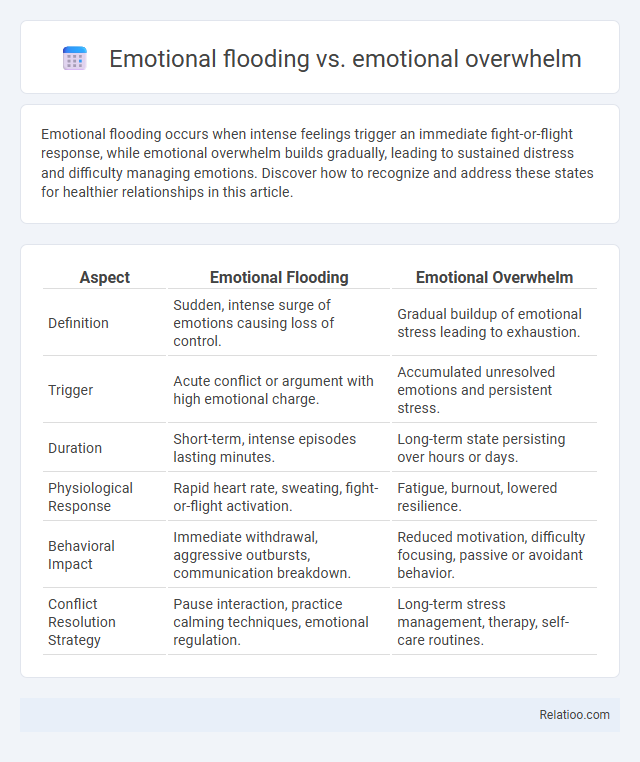Emotional flooding occurs when intense feelings trigger an immediate fight-or-flight response, while emotional overwhelm builds gradually, leading to sustained distress and difficulty managing emotions. Discover how to recognize and address these states for healthier relationships in this article.
Table of Comparison
| Aspect | Emotional Flooding | Emotional Overwhelm |
|---|---|---|
| Definition | Sudden, intense surge of emotions causing loss of control. | Gradual buildup of emotional stress leading to exhaustion. |
| Trigger | Acute conflict or argument with high emotional charge. | Accumulated unresolved emotions and persistent stress. |
| Duration | Short-term, intense episodes lasting minutes. | Long-term state persisting over hours or days. |
| Physiological Response | Rapid heart rate, sweating, fight-or-flight activation. | Fatigue, burnout, lowered resilience. |
| Behavioral Impact | Immediate withdrawal, aggressive outbursts, communication breakdown. | Reduced motivation, difficulty focusing, passive or avoidant behavior. |
| Conflict Resolution Strategy | Pause interaction, practice calming techniques, emotional regulation. | Long-term stress management, therapy, self-care routines. |
Understanding Emotional Flooding
Emotional flooding occurs when intense emotions, such as anger or fear, overwhelm the brain's capacity to regulate responses, leading to impaired decision-making and heightened stress levels. Unlike general emotional overwhelm, which involves feeling burdened by multiple emotions simultaneously, emotional flooding specifically refers to a rapid, uncontrollable surge of a single dominant emotion. Understanding emotional flooding is critical for developing effective coping strategies in therapy, such as mindfulness and breathing techniques, to prevent escalation and maintain emotional balance.
Defining Emotional Overwhelm
Emotional overwhelm occurs when Your emotional responses become so intense and multifaceted that they impede clear thinking and decision-making, distinct from emotional flooding which is characterized by a sudden, intense surge of emotions often triggered by specific events. Unlike emotional flooding's acute episodes, emotional overwhelm can persist, encompassing an accumulation of stressors leading to chronic emotional distress. Understanding emotional overwhelm involves recognizing its pervasive impact on mental health and daily functioning, necessitating strategies for regulation and emotional resilience.
Key Differences Between Emotional Flooding and Overwhelm
Emotional flooding involves a sudden surge of intense emotions that temporarily impair cognitive functioning, often triggered by acute stress or conflict. Emotional overwhelm refers to a prolonged state where emotions accumulate, causing persistent distress and difficulty in managing daily tasks. Key differences include the immediacy and intensity of emotional flooding versus the gradual, sustained pressure characteristic of emotional overwhelm, impacting coping mechanisms differently.
Common Triggers for Emotional Flooding
Common triggers for emotional flooding include intense stress, unresolved trauma, and high-pressure situations that overwhelm your ability to process emotions effectively. Emotional flooding happens when these triggers cause your nervous system to become hyper-aroused, leading to a flood of uncontrollable feelings that impair rational thinking. Recognizing these triggers helps manage emotional overwhelm by preventing the cascade of stress that results in emotional flooding.
Causes of Emotional Overwhelm
Emotional overwhelm occurs when your brain processes excessive emotional stimuli, often triggered by stress, anxiety, or unresolved trauma, leading to difficulty managing feelings effectively. Unlike emotional flooding, which is an intense, acute surge of emotion that can temporarily paralyze your response, emotional overwhelm builds gradually and impairs your ability to cope over time. Understanding the causes of emotional overwhelm, including chronic stress, sensory overload, and emotional buildup, is essential for developing strategies to regain emotional balance and resilience.
Signs and Symptoms to Recognize
Emotional flooding manifests through intense physiological reactions like rapid heartbeat, sweating, and a sense of being physically overwhelmed, often triggered by acute stress or confrontation. Emotional overwhelm is characterized by cognitive overload, difficulty concentrating, feeling mentally paralyzed, and an inability to process emotions effectively. Recognizing these signs and symptoms enables early intervention, such as grounding techniques and emotional regulation strategies, to prevent escalation and promote mental well-being.
Impact on Mental Health and Relationships
Emotional flooding, characterized by an intense and sudden surge of feelings, can severely disrupt your mental health by causing anxiety, panic attacks, and impaired cognitive function, leading to difficulty in managing stress. Emotional overwhelm, often a cumulative effect of prolonged stress and unresolved emotions, can result in burnout, depression, and strained relationships due to decreased emotional regulation and communication breakdown. Both emotional flooding and overwhelm negatively impact relationships by fostering misunderstandings, reducing empathy, and increasing conflict, highlighting the importance of developing coping mechanisms to maintain emotional balance.
Coping Strategies for Emotional Flooding
Emotional flooding occurs when intense feelings suddenly overwhelm your ability to process emotions, causing a surge of stress responses that impair judgment and communication. Emotional overwhelm is a broader state where multiple stressors accumulate, leading to exhaustion but not necessarily the acute intensity seen in flooding. Coping strategies for emotional flooding include grounding techniques, controlled breathing, and mindfulness practices to help regulate emotions and regain mental clarity quickly.
Techniques to Manage Emotional Overwhelm
Techniques to manage emotional overwhelm include grounding exercises such as deep breathing, mindfulness meditation, and progressive muscle relaxation, which help reduce the body's stress response. Cognitive reframing allows you to challenge and change distorted thought patterns fueling emotional flooding and overwhelm. Establishing clear boundaries and practicing self-compassion are essential strategies that support your emotional resilience and prevent recurring emotional flooding episodes.
When to Seek Professional Help
Recognizing the difference between emotional flooding, emotional overwhelm, and emotional flooding is crucial for managing your mental health effectively; emotional flooding involves intense, uncontrollable emotional reactions, while emotional overwhelm is characterized by feeling swamped by multiple stressors. Seek professional help when emotional responses consistently impair your daily functioning, relationships, or decision-making abilities. Early intervention by a therapist or counselor can provide coping strategies tailored to your specific emotional challenges.

Infographic: Emotional flooding vs Emotional overwhelm
 relatioo.com
relatioo.com